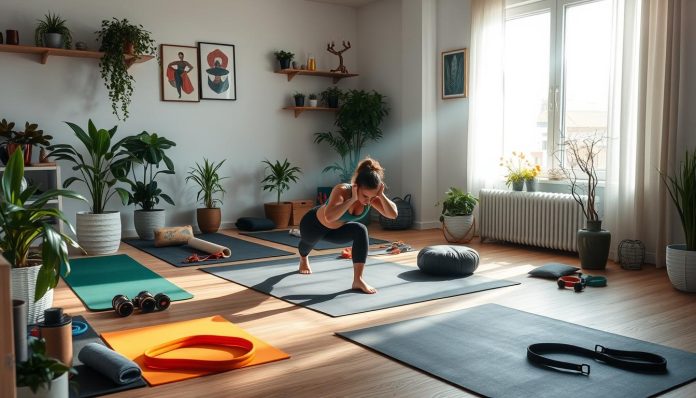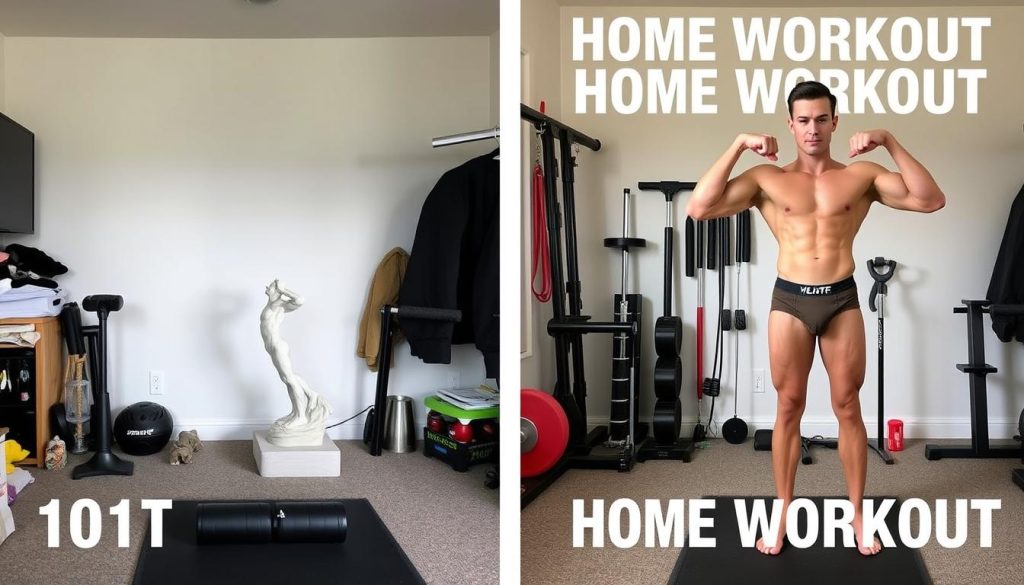Building muscle at home without equipment is a fantastic way to start your fitness journey. You can work out anywhere, anytime, without expensive gym memberships or equipment. Bodyweight exercises and using your own weight as resistance are key to building strength, endurance, and flexibility.
Studies show that lighter bodyweight exercises like gym workouts can lead to muscle gains. This means you can reach your muscle-building goals at home using bodyweight exercises. You can see significant results in building muscle at home with the right approach.
Key Takeaways
- You can build muscle at home with no equipment using bodyweight exercises.
- Bodyweight exercises can be just as effective as weightlifting for building muscle.
- Progressive overload is key to building muscle, and can be achieved through increases in repetitions or sets.
- A healthy and balanced diet is essential for supporting muscle growth.
- Consistency and patience are key for seeing results from your muscle building at home workout routine.
- How to build muscle at home with no equipment requires creativity and adaptability to overcome resistance limitations.
- Muscle building at home using bodyweight exercises can be a fun and effective way to get in shape.
Understanding Muscle Building Basics
Muscle building at home is all about the basics. You can build muscle without weights if you use the right techniques and challenge your muscles. A good home workout should mix cardio and strength training, focusing on HIIT workouts a few times a week.
Progressive overload is key in muscle building. It means you increase the weight or resistance you use over time. You can use bodyweight exercises or makeshift weights like water bottles or backpacks. Start with a certain number of reps and sets, then increase the difficulty as you get stronger.
Being consistent is important for muscle building. Work out 2-3 times a week, with at least one day of rest in between. Each session should last 30-60 minutes, covering different muscle groups. Don’t forget to include active rest days, like gentle cycling or walking, to help your muscles recover.
Good nutrition is also essential for muscle growth. Eat about 1 gram of protein per pound of body weight daily, spread across all meals. You also need a caloric surplus to grow muscle, so add 500 calories to your daily intake.
Key Bodyweight Exercises to Get Started
Bodyweight exercises are great for building muscle at home. They need little equipment and can be done anywhere. This makes them perfect for a home workout for muscle gain. To build muscle at home fast, focus on exercises that work many muscles at once.
A good bodyweight exercises routine can help you reach your fitness goals. Push-ups, squats, and planks are very effective. They can be adjusted to fit your fitness level. Doing these exercises helps build strength, endurance, and flexibility.
Remember, consistency and patience are key as you progress. Aim to do your bodyweight exercises 2-4 times a week. Make sure to rest for 48 hours between workouts for the same muscle groups. With dedication and the right approach, you can build muscle at home fast and reach your fitness goals.
Variations of Bodyweight Exercises
There are many bodyweight exercises variations to keep your workouts interesting. Try different push-ups, like close-grip or diamond push-ups, to target specific muscles. You can also modify squats to work different muscles, like sumo or pistol squats.
Importance of Proper Form
Proper form and technique are key when doing bodyweight exercises. They help avoid injuries and ensure you’re working the right muscles. Take time to learn proper form and adjust exercises as needed to fit your fitness level.
Crafting a Home Workout Routine
Building muscle at home starts with a good workout plan. A well-structured routine helps you reach your fitness goals. It’s best to start with full-body workouts that include push-ups, squats, and lunges. These exercises can be adjusted to fit your fitness level and goals, making them perfect for weight-free muscle building.
Your home workout should mix strength training and cardio. Cardio boosts your fitness and endurance. Start with a 5-minute warm-up, then do strength training exercises. Finish with 10-15 minutes of cardio. This mix helps build muscle and improves health.
Consistency and patience are key in a home workout routine. Listen to your body and take rest days when needed. With a good plan and dedication, you can build muscle without weights. Make your home workout a daily habit to achieve strong, lean muscles quickly.
Full-Body Workout Sample
A full-body workout includes squats, push-ups, and lunges. Start with 3 sets of 8-12 reps and increase as you get stronger. Remember to add cardio like jumping jacks or burpees to boost endurance and burn calories.
Frequency: How Often Should You Train?
How often you work out depends on your fitness level and goals. Aim for 2-3 workouts a week, with a day of rest in between. This allows your muscles to recover and grow, leading to stronger muscles over time.
Utilizing Everyday Items as Makeshift Weights
Building muscle at home can be tough without the right gear. But, you can make weights from things you already have. This way, you can build muscle at home fast and follow an effective home workout routine.
Water bottles or backpacks can be used as dumbbells. Fill the bottles with sand or water, or pack the backpack with heavy books. This adds the needed resistance to work your muscles.
Household items like laundry detergent jugs or empty milk cartons also work. Fill them with water or sand for makeshift weights. Adding these to your routine makes for a tough and effective home workout routine that helps you build muscle at home fast.
Being creative is key to muscle building at home. With a bit of imagination, you can turn common items into great workout tools. This way, you can reach your fitness goals without spending a lot.
Importance of Warm-Up and Cool Down
Remember, warm-up and cool-down routines are key in a home workout for muscle gain. A good warm-up prevents injury and boosts performance. A cool-down helps your muscles recover and rebuild. By adding these routines to your workout, you can avoid injuries and get fitter.
Studies show warming up before a workout is vital. It prevents injuries and enhances performance. For a home workout, try jogging in place, jumping jacks, or cycling. These activities increase blood flow and prepare your muscles for exercise.
Effective Warm-Up Routines
A warm-up should last 3-5 minutes and include dynamic exercises. Leg swings, arm circles, and hip rotations are good. For example, start with 30 seconds of jumping jacks, then 30 seconds of leg swings.
Stretches for Muscle Recovery
A cool-down should also last 3-5 minutes and include static stretches. Focus on hamstring, quadriceps, and chest stretches. These stretches help your muscles recover and rebuild. They reduce injury risk and improve fitness. Adding these stretches to your home workout can help you build muscle better.
Tracking Progress: Staying Motivated
To reach your muscle building goals, tracking your progress is key. Monitoring your workouts and diet helps you see what works and what doesn’t. Keeping a workout journal is a great way to track your progress. It lets you record your exercises, sets, reps, and weight, showing how far you’ve come.
Using muscle building tips and the best exercises to build muscle at home can speed up your gains. A good workout plan and healthy diet are also important. Remember, building muscle takes time, effort, and patience.
Seeing your progress can keep you motivated. It shows the results of your hard work, pushing you to keep going. Whether you’re new or experienced, tracking your progress is vital for success.
Why Progress Tracking is Essential
Tracking your progress is important for several reasons. It helps you see where you need to get better, so you can make changes. It also keeps you motivated, as seeing your progress keeps you focused. By tracking your progress, you know you’re on the right track to your muscle building goals.
Keeping a Workout Journal
Keeping a workout journal is a simple yet effective way to track your progress. By recording your workouts, you can see how you’ve improved over time. You can also track your nutrition, making sure you’re eating right to support your goals.
Nutrition Tips for Muscle Building
Nutrition is key when building muscle at home. A balanced diet fuels your muscles to recover and grow. Include protein-rich foods like chicken, fish, and eggs in your meals to help muscles grow.
Protein-Rich Foods to Incorporate
Timing your meals is important for muscle building at home. Eat a meal with protein and carbs an hour before working out. This gives you energy and supports muscle function. After working out, eat something with protein to help your muscles recover.
Meal Timing: When to Eat for Optimal Gains
Combine a regular workout routine with good nutrition for muscle gain. Building muscle at home needs patience, consistency, and the right food. This is true, even when you’re not using weights.
Incorporating Rest and Recovery
Rest and recovery are key when it comes to muscle building tips. To build muscle at home fast, your muscles need time to recover and rebuild. The best exercises to build muscle at home should be balanced with enough rest.
Sleep is vital for recovery. It helps your body repair and grow muscle tissue. So, aim for 7-9 hours of sleep each night to aid in muscle recovery.
Active recovery methods like foam rolling and stretching also help. They reduce muscle soreness and boost fitness. Adding these to your routine can improve your muscle building tips and workout results.
Setting Realistic Goals
When you’re trying to build muscle at home, setting realistic goals is key. You need a plan that covers both short-term and long-term goals. For example, a short-term goal might be to do a 30-minute workout three times a week. A long-term goal could be to see a big increase in muscle mass in six months, without using weights.
To make your goals easier to reach, make them specific, measurable, and have a deadline. For instance, you might aim to increase your workout time by 10 minutes each week. It’s also important to find what motivates you, like better health, a better body, or more confidence.
Success comes from being consistent and patient. Don’t rush the process and listen to your body. Adjust your goals as needed. With a solid plan and dedication, you can see real gains in muscle and fitness, even without weights.
Short-Term vs. Long-Term Muscle Goals
It’s important to know the difference between short-term and long-term goals. Short-term goals give you a sense of achievement and keep you motivated. Long-term goals help you stay focused on your bigger picture. By balancing both, you create a plan that meets your needs and helps you succeed in building muscle at home.
Finding Your Personal Motivation
Finding what motivates you is essential to sticking with your workout plan. It could be wanting better health, looking good, or feeling more confident. Your motivation will help you overcome obstacles and stay on track with your goals. By knowing what drives you, you can make your workout plan more effective and lasting, even without weights.
Overcoming Common Challenges
Starting your muscle-building journey at home can face several hurdles. Staying motivated is tough, but having a workout buddy or joining a fitness group helps. It makes the journey more fun and keeps you on track.
Dealing with small spaces and limited resources is another challenge. But, many effective bodyweight exercises can be done in little space. Push-ups, squats, and planks are great for building muscle at home. By sticking to these exercises and your goals, you can beat common obstacles and succeed in your fitness journey.
Building muscle at home needs dedication and hard work. By following good muscle-building tips and staying motivated, you can beat common challenges. With the right mindset and a solid workout plan, you can build muscle at home fast. This brings many benefits, like better health and more confidence.
Staying Motivated at Home
To stay motivated at home, make your workouts fun and engaging. Listen to music, watch fitness videos, or work out with a friend. This way, you’ll stay motivated and focused on your goals, even when faced with challenges.
Dealing with Limited Space and Resources
When space and resources are limited, be creative and flexible. Use bodyweight exercises, incorporate household items, or find new places to exercise. Being resourceful and adaptable helps you overcome obstacles and reach your fitness goals, even with limited resources.
Expanding Your Knowledge
As you keep working on muscle building at home, it’s key to know the latest in fitness. This helps you fine-tune your home workout for muscle gain and get better results. The best thing about muscle building without weights is you can change your routine as you get stronger.
Research shows knowing more and keeping up with fitness trends helps you reach your goals. You can read books and articles, and join online groups for support. This keeps you motivated and teaches you new ways to get fit.
Online forums and social media groups are great for muscle building at home. They offer lots of info and support. You can meet others who share your goals and learn from their experiences. Using these resources can boost your home workout for muscle gain and help you reach your goals faster.
Remember, success in muscle building without weights comes from being consistent and patient. By staying informed, adjusting your routine, and pushing yourself, you can get the results you want. And you’ll stay healthy and active too.
Conclusion: Start Your Muscle-Building Journey Today!
Building muscle at home might seem tough, but it’s doable with the right plan and dedication. Muscle building tips like choosing best exercises to build muscle at home and staying focused on build muscle at home fast are essential. These tips will help you succeed.
This guide has given you the tools to start building the body you want. Take on the challenge, stay motivated, and begin your muscle-building journey now. With hard work and patience, you can change your body and meet your fitness goals, all from home.
FAQ
What is muscle hypertrophy?
Muscle hypertrophy is when your muscles get bigger. This happens with regular strength training and the right food.
How important is nutrition for muscle building?
Nutrition is very important for growing muscles. It gives your muscles the fuel they need to heal and grow. Eating foods high in protein and timing your meals right are key.
Why is consistency essential for muscle building?
Being consistent is key. It helps you keep moving forward and reach your goals. Regular workouts and a balanced diet are essential for muscle growth.
What are the best bodyweight exercises for muscle building?
Push-ups, squats, and planks are top choices. They work many muscles and can be adjusted for different fitness levels.
How often should I train to build muscle at home?
How often you work out depends on your fitness level and goals. Make sure to rest for at least two days in between to let your muscles recover.
How can I add resistance to my home workouts?
Using everyday items like water bottles and backpacks is a smart way to add resistance. It challenges your muscles during workouts at home.
Why is warming up and cooling down important?
Warming up prevents injuries and boosts performance. Cooling down helps your muscles recover and rebuild.
How can I track my progress?
Keeping a workout journal or using a mobile app helps track your progress. It lets you set goals and see your hard work’s results, keeping you motivated.
What are the best ways to incorporate rest and recovery?
Sleep is essential for muscle growth. Active recovery like foam rolling and stretching also helps reduce soreness and boosts fitness.
How can I stay motivated while working out at home?
Having a workout buddy or joining a fitness community keeps you motivated. It helps even when you’re working out at home with limited space.



